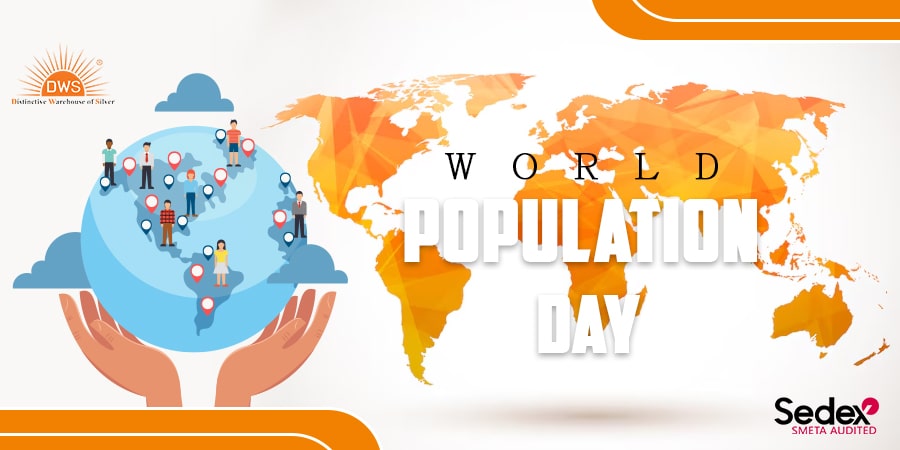- Written By Team DWS
- Festivals
- June 16, 2025
Celebrating World Population Day: Understanding Our Growing Global Family
Every year, on July 11, we commemorate World Population Day, aiming to raise awareness about global population issues and their impact on our lives. Established by the United Nations Development Programme in 1989, this day serves as a reminder of our responsibility to ensure a sustainable future for all. As we gather to celebrate our global family, it’s essential to reflect on both the challenges and opportunities that come with a growing population of nearly 8 billion people.

The Significance of World Population Day
World Population Day’s inception was inspired by the Day of Five Billion on July 11, 1987, marking the date when the world’s population reached that milestone. Since then, our global family has grown exponentially, and with it comes a myriad of concerns, including resource allocation, climate change, and economic sustainability. This annual observance serves as a platform to engage governments, non-governmental organizations, and communities in discussions aimed at addressing these challenges.
Understanding Global Population Trends
As we celebrate World Population Day, let’s take a closer look at some significant trends shaping our world today. According to the United Nations, the global population is expected to reach approximately 9.7 billion by 2050 and could surpass 10.4 billion by the end of the century. While some regions are experiencing rapid population growth, others are facing stagnation or decline.
- Aging Populations: In areas like Europe and East Asia, populations are aging dramatically, which can strain pension systems and healthcare services. The share of seniors, defined as those over 65, will grow significantly, influencing everything from labor markets to healthcare policies.
- Youthful Demographics: Conversely, regions in Sub-Saharan Africa and South Asia are witnessing explosive growth, characterized by large youth populations. This demographic can provide tremendous economic potential if they are equipped with education, job opportunities, and adequate health services.
- Urbanization: More than half of the world's population currently lives in urban areas, a figure projected to rise to nearly 68% by 2050. Rapid urbanization poses unique challenges, including infrastructure strain, housing shortages, and increased pollution. However, urban centers also serve as hotspots for innovation, culture, and economic activity.
- Migration: Global migration patterns are shifting as people move in search of better opportunities. Whether due to conflict, economic hardship, or climate change, migration contributes to the fabric of diverse societies but also raises questions about integration and social cohesion.
The Challenges of Growth
With a growing population comes a spectrum of challenges that demand our immediate attention.
- Resource Distribution: The delicate balance of resource distribution becomes even more critical. As our numbers swell, the demand for food, water, and energy increases. According to the Food and Agriculture Organization, food production must rise by 70% by 2050 to meet the nutritional needs of the population. This challenge is compounded by the effects of climate change, which threaten agricultural output.
- Healthcare Access: As populations expand, particularly in developing nations, access to healthcare can become strained. The global community must work together to ensure that everyone has access to necessary medical resources to combat diseases, improve maternal health, and enhance child survival rates.
- Environmental Impact: Human activity has a direct impact on the environment, contributing to climate change, biodiversity loss, and habitat destruction. A larger population means a greater ecological footprint, leading to calls for sustainable practices and policies.
Opportunities for Growth
While the challenges are significant, it’s essential to acknowledge the opportunities that a growing population presents.
- Innovation in Technology: A larger population can fuel innovation as more minds contribute ideas and solutions to pressing issues. The integration of technology in areas like agriculture, healthcare, and education can lead to smarter, more efficient systems that benefit society as a whole.
- Economic Growth: An expanding workforce creates potential for economic growth. Investing in education and job training enables individuals to contribute meaningfully to the economy, reducing unemployment and poverty levels.
- Cultural Exchange: Migration and globalization foster cultural exchange, enriching societies with diversity and creating opportunities for collaboration in arts, sciences, and social development.
Taking Action
As we celebrate World Population Day, it is crucial to recognize the interconnectedness of our global community. Governments, NGOs, and individuals must work together to address population-related challenges with compassion, creativity, and determination. Here are some actions we can take:
- Support Family Planning: Promote access to reproductive health services and education. Empowering individuals to make informed choices about family size benefits both individuals and society.
- Invest in Education: Prioritize education for children and youth, especially girls, to create empowered community leaders of the future.
- Promote Sustainable Practices: Advocate for policies and practices that support environmental sustainability to protect our planet for generations to come. This can include reducing waste, conserving energy, and supporting renewable resources that can sustain our growing population without further harming the planet.
- Enhance Healthcare Access: Work towards improving healthcare infrastructure, particularly in underserved areas. This means advocating for policies that ensure affordable healthcare services and resources are available to everyone, regardless of their economic situation.
- Encourage Community Engagement: Foster a culture of community involvement, where individuals come together to share ideas, solutions, and collaborate on projects that can uplift entire neighborhoods and regions. This can strengthen social bonds and promote mutual support.
- Address Migration Issues: Develop policies that facilitate the integration of migrants into societies while respecting their rights and cultural backgrounds. Creating inclusive communities can enhance social cohesion and economic productivity.
- Promote Research and Data Collection: Support initiatives that gather reliable data on population trends and demographics to inform policy decisions. Understanding the nuances of population dynamics can help governments and organizations strategize effectively.
As we mark World Population Day, let us remember that the responsibility of addressing population issues lies with each of us. Together, we can create a sustainable and equitable world, ensuring the well-being of future generations while honoring the diverse tapestry of humanity. Embracing these challenges as opportunities will pave the way for a brighter, more sustainable future for our global family.

World Population Day FAQs: Everything You Need to Know
Sure! Here’s a list of frequently asked questions (FAQs) about World Population Day, which is observed on July 11 each year:
1. What is World Population Day?
World Population Day is an annual event held on July 11 to raise awareness about global population issues, including overpopulation, family planning, gender equality, and the impact of population growth on the environment and development.
2. When was World Population Day established?
World Population Day was established by the Governing Council of the United Nations Development Programme (UNDP) in 1989, in response to the global population reaching 5 billion on July 11, 1987.
3. What is the theme for World Population Day?
Each year, World Population Day has a specific theme that focuses on various demographic issues. The theme may vary based on current global challenges related to population. For the latest theme, you can check the official UN website or related announcements.
4. Why is World Population Day important?
This day serves to highlight critical population issues such as poverty, maternal health, gender equality, and sustainable development. It encourages countries and organizations to take action and promote awareness about these challenges.
5. How is World Population Day observed?
World Population Day is observed through various activities, including educational campaigns, workshops, seminars, public discussions, and social media outreach. Governments, NGOs, and community organizations may hold events to raise awareness.
6. How can individuals participate in World Population Day?
Individuals can participate by educating themselves and others on population issues, advocating for sustainable practices, supporting family planning initiatives, and participating in local events or discussions related to population and development.
7. What are some key issues that World Population Day focuses on?
Some of the key issues include:
- Family planning access and reproductive health.
- Gender equality and women's empowerment.
- Population control and sustainability.
- Climate change and its demographic impacts.
- Poverty and development.
8. What message does World Population Day convey?
The core message of World Population Day is to promote awareness and action regarding population-related issues and to emphasize the importance of sustainable development for current and future generations.
9. What role does the United Nations play in World Population Day?
The United Nations plays a pivotal role in organizing and promoting World Population Day. Through its various agencies, like the United Nations Population Fund (UNFPA), the UN provides resources, research, and events to support global awareness and action regarding population issues.
10. Where can I find more information about World Population Day?
More information can be found on the United Nations Population Fund (UNFPA) website, as well as through other reputable organizations that focus on population and development issues.
---
Feel free to adapt any of these FAQs to suit your needs!
Popular on Blogs

Black Tourmaline: Meaning, Healing Properties, Fascinating Facts, Powerful Attributes, Versatile Uses, and Beyond
September 05, 2023 / BY Team DWS
Black Tourmaline, also known as Schorl, is a highly revered crystal with incredible metaphysical properties. It derives its name from the Dutch word "turamali," meaning "stone with ..

Carnelian Stone: Meaning, Healing Properties, Power, Facts, Color, Uses and More
December 26, 2023 / BY Team DWS
Carnelian is a vibrant and captivating gemstone that holds a plethora of meanings, healing properties, and powers. Its warm and fiery energy makes it a popular choice among crystal ..

Citrine: Exploring its Meaning, Healing Properties, Fascinating Facts, Powers, Versatile Uses, and Much More
November 18, 2023 / BY Team DWS
Citrine, with its warm golden hues, has captured the attention and imagination of people for centuries. This beautiful gemstone, commonly associated with wealth and prosperity, hol ..

Black Onyx: Unveiling the Meaning, Healing Properties, Fascinating Facts, Powerful Attributes, Versatile Uses, and Beyond
July 25, 2023 / BY Team DWS
Black Onyx, a striking gemstone admired for its deep black hue and elegant appearance, has captivated people for centuries. In this comprehensive guide, we will delve into the mean ..

Unveiling the Mysteries of Turquoise Stone: Exploring its Meaning, Healing Properties, Power, Facts, Color, Uses, and More
December 05, 2023 / BY Team DWS
Turquoise, with its captivating blue-green hue, has been adorning jewelry and artifacts for centuries. This striking stone has a rich history, rich symbolism, and a plethora of int ..

The History Behind The Popularity of Red Agate
December 23, 2022 / BY Team DWS
An Agate is a type of magma rock that takes many years till it is washed out naturally into the water. And that is the reason this stone has elements of water. This beautiful stone ..

Plan a Perfect Valentine's Week with Our Valentine Week List 2025
January 22, 2024 / BY Team DWS
Valentine's Day is undoubtedly the most romantic day of the year, but we believe that one day is just not enough to express your love and make your partner feel special. That's why ..

Bloodstone: Unveiling the Meaning, Healing Properties, Facts, Powers, Uses, and More
August 21, 2023 / BY Team DWS
Bloodstone, with its captivating deep green color with specks of red, is a mesmerizing gemstone that has fascinated civilizations for centuries. It possesses unique healing propert ..


